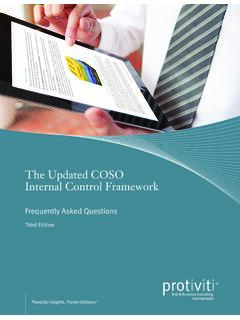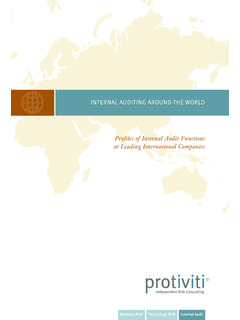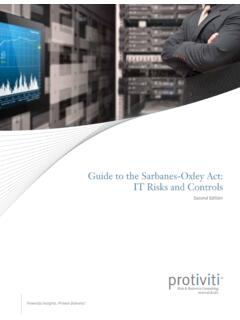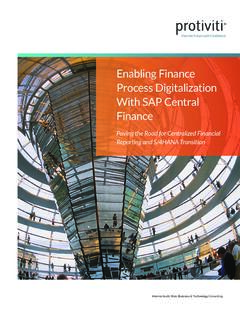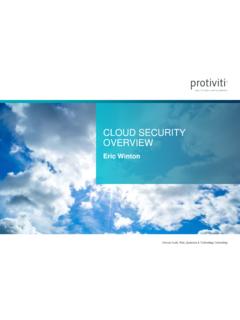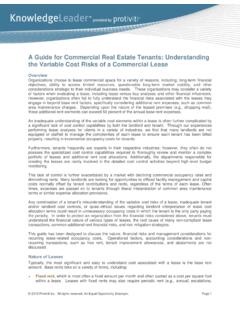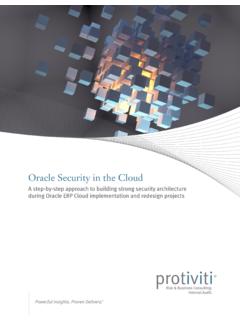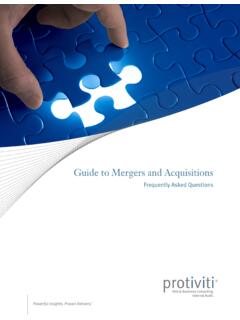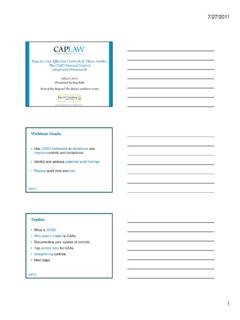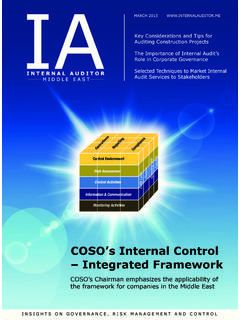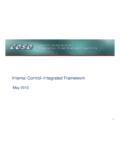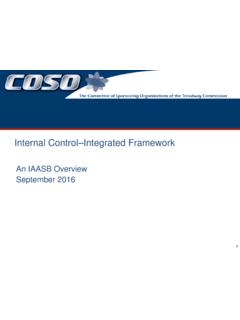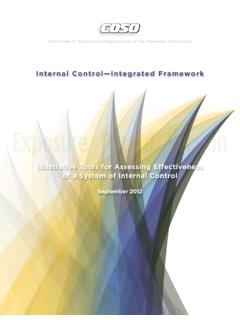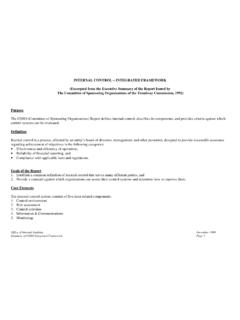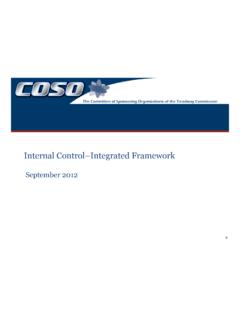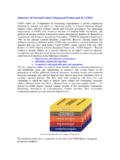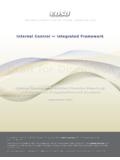Transcription of The Updated COSO Internal Control Framework - …
1 The Updated coso Internal Control FrameworkFrequently Asked QuestionsThe Updated coso Internal Control Framework | FAQs iIntroductionThe Committee of Sponsoring Organizations of the Treadway Commission ( coso ) an organization providing thought leadership and guidance on Internal Control , enterprise risk management (ERM) and fraud deter-rence has released its long-awaited Updated Internal Control integrated Framework (New Framework ). The original version ( Framework ), released by coso in 1992, has gained broad acceptance. It has been widely used, particularly as a suitable and the predominant Framework in conjunction with reporting on the effectiveness of Internal Control over financial reporting by public companies listed in the United States in accordance with Section 404 of the Sarbanes-Oxley Act.
2 Today, this time-tested Framework continues to be recognized as a leading resource for purposes of providing guidance on the design and evaluation of Internal New Framework issued by coso is an important development, as it facilitates efforts by organizations to develop cost-effective systems of Internal Control to achieve important business objectives and sustain and improve performance. It also supports organizations as they adapt to the increasing complexity and pace of a changing business environment, manage risks to acceptable levels and improve the reli ability of information for decision-making. Companies using the 1992 Framework for Sarbanes-Oxley compliance and other purposes should familiarize themselves with the New Framework and companion materials, determine their transition plan, and communicate to the appropriate stakeholders the release of the New Framework and its implications to the orga-nization.
3 It is hoped that this guide will help them get started. This guide addresses various questions regarding the New Framework from coso , including the reasons why it was Updated ; what has changed; the process for transitioning to its use; and steps companies should take now. For interested parties, the New Framework is available at ProtivitiMay 2013 The Updated coso Internal Control Framework | FAQs iiContentsIntroduction ..i1. Who is coso ? ..12. How did the project to update the 1992 Framework unfold? ..13. How is the Updated Framework organized? ..14. Why update the 1992 Framework ? ..15. What hasn t changed? ..26. What has changed? ..37. What s the most important change? ..48. How are points of focus applied? ..69. How are deficiencies in Internal Control assessed?
4 1010. What does present and functioning mean? ..1111. How does management assess whether all components operate together ? ..1112. Are external parties a part of the system of Internal Control ? ..1113. When are we required to apply the New Framework ? ..1214. What if we continue to apply the original Framework beyond coso s transition period? ..1215. What are the implications for Sarbanes-Oxley compliance? ..1216. How do we disclose in our annual Internal Control report which Framework we use during the transition period? ..1217. What do we need to do now? ..1318. What tasks are necessary in applying the 2013 New Framework ? ..1319. To whom do we communicate and what do we tell them? ..1320. Will there be a street reaction to companies that do not early apply ?
5 1321. Does the New Framework comment on the limitations of Internal Control ? ..1422. How do we use the illustrative tools for assessing effectiveness of a system of Internal Control ? ..1423. Why did coso issue the Internal Control over External Financial Reporting: A Compendium of Approaches and Examples? ..1424. Are we required to use the External Financial Reporting Compendium? ..1425. How does the New Framework relate to ERM? ..15 About Protiviti ..16 The Updated coso Internal Control Framework | FAQs 11. Who is coso ?The Committee of Sponsoring Organizations was organized in 1985 to sponsor the National Commission on Fraudulent Financial Reporting, an independent private-sector initiative that studied the causal factors that can lead to fraudulent financial reporting.
6 It also developed recommendations for public companies and their indepen-dent auditors, for the Securities and Exchange Commission (SEC) and other regulators, and for educational institutions. It is sponsored jointly by five major professional associations headquartered in the United States: the American Accounting Association (AAA), the American Institute of Certified Public Accountants (AICPA), Finan-cial Executives International (FEI), The Institute of Internal Auditors (IIA), and the Institute of Management Accountants (IMA). 2. How did the project to update the 1992 Framework unfold?In 2010, coso decided to update the 1992 Framework with a fresh look and engaged PricewaterhouseCoopers (PwC) to do the project. An Advisory Council was formed consisting of representatives from industry, academia, government agencies and not-for-profit organizations to provide input as the project progressed.
7 Protiviti had a representative on the Advisory Council. Exposure drafts were issued to the public for comment and coso received feedback in the form of responses to an online survey as well as public comment letters. Based on this input, coso finalized the update, resulting in the New How is the Updated Framework organized? Developed and authored by PwC under the direction of the coso Board over a two-and-a-half year period, the New Framework and related illustrative documents consist of an executive summary, the New Framework itself, several appendices,1 an applications guide providing illustrative tools, and a separate compendium of approaches and examples for application of the New Framework to Internal Control over financial Why update the 1992 Framework ?
8 If it ain t broke, don t fix it. This old saying begs a question regarding the 1992 Framework : Was it broken? In a word: No. In the spirit of continuous improvement, coso s decision to update the Framework was driven by the extent of change over the past two decades. Much has happened in the business environment since 1992. For example, expectations for governance oversight have increased; risk and risk-based approaches now receive greater attention; globalization of markets and operations has become a megatrend; the complexity of business and orga-nizational structures has increased, including outsourcing and strategic suppliers; technology has evolved dramati-cally; and the demands and complexities in laws, regulations and standards have all increased substantially.
9 We also have seen the damaging effects of spectacular, large-scale governance and Internal Control breakdowns, including the derivatives fiascos of the 1990s, Long-Term Capital Management, the Enron era, and the more recent global financial crisis. These breakdowns have taught valuable lessons around a number of themes for example, the effects of management override, conflicts of interest, lack of segregation of duties, poor or nonexis-tent transparency, siloed risk management, ineffective board oversight, and unbalanced compensation structures that enabled or drove dysfunctional and/or irresponsible behavior. While no Internal Control Framework provides answers to all of these issues, there is no denying that much has transpired since coso s 1992 Framework was issued, and it makes sense for it to be Updated in light of those changes.
10 Add to the above developments the increased expectations for competencies and accountabilities at all levels of organizations, and the heightened expectations around preventing and detecting fraud, and you ve got a viable business case for a refresh of a 20-year-old Framework . 1 The appendices include a glossary of key terms, a summary of roles and responsibilities, a discussion of the process used to update the Framework , a discussion of the comment letters received, a summary of changes to the 1992 Framework , and a comparison of the New Framework with coso s Enterprise Risk Management integrated Framework . The Updated coso Internal Control Framework | FAQs 25. What hasn t changed?Those experienced at using the 1992 version will find much familiar in the 2013 New Framework , as it builds on what has proven effective in the original release.
